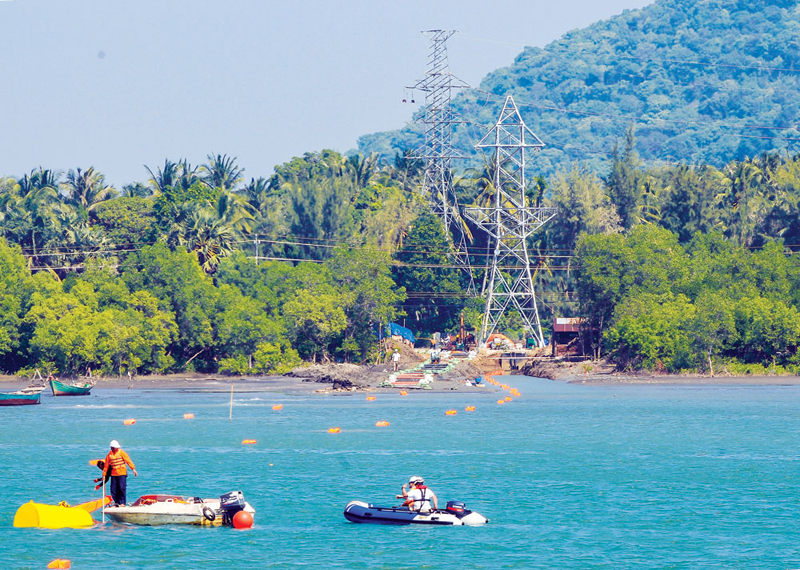Adaptation to storms and tides, etc.
EVN as well as contractors have faced a lot of difficulties and challenges when implementing projects to bring the national power grid to islands. They are the severity of weather at the sea; complicated construction conditions; difficulties in transporting materials, raw materials, etc. In some projects, foundations of over 10 m high electric poles were constructed at the edge of the island with vertical cliffs; or sometimes storms, tropical low pressure, etc. attacked when the project was under construction.
Typically, when the Southern Power Corporation (EVNSPC) implemented project “Delivering the national grid - connected electricity to Lai Son island (Kien Hai district, Kien Giang province)”, the project construction was performed under the weather condition of strong winds up to level 5 or higher during up to 40% of the construction time. Construction engineers and workers at times had to urgently transport equipment such as piling hammers, concrete mixing plants, etc. back to the shore to protect them from waves.
Even, there were times when sea turbulence constantly affected the project progress. Therefore, when the weather conditions were tolerable, the contractors had to intensify their work forces to work day and night in order to keep the project on the right track. In addition, in many cases, the contractors had to adapt their construction activities to the tides.
Coastal waters of Kien Giang province are the area where many fishing boats operate, so the maritime safety and construction safeguarding are quite intricate. Several conflicts occurred between boats of fishermen and the construction site, which caused damages to foundation buttresses and consequently delayed the construction time.
When the project of bringing the national power grid to Phu Quoc Island was about to finish, an incident due to a broken underground cable (with bubbles in the cable) occurred. It was noted that the underground cable had been buried deep under the seabed 2m, weighing thousands of tons, therefore how to lift it up the water surface for troubleshooting was not simple. To keep the project on schedule, dozens of Vietnamese and foreign engineers were mobilized and worked in three weeks to remedy the incident and energize the project in the Lunar New Year 2014.

EVN has weathered numerous hardships and difficulties to deliver on-grid electricity for lighting up remote islands.
Cutting stones for laying cable
The first underground cable was installed from Cu Lao Cham Island to the mainland of Hoi An. However, the barges carrying cables encountered difficulties in getting to the end point of the cable at Cu Lao Cham island due to geological structure of the coastline with many large stones.
In order to lay cables, construction crews had to utilize specialized vehicles to cut and cleave each stone to form a cable laying groove. Stone cutting machines operated unceasingly, dozens of divers dove deep in the water and a variety of specialized machines and equipment were mobilized to help clear the way for laying the cable down on the seabed.
In the project of bringing the national power grid to Cai Chien island commune (Hai Ha district, Quang Ninh province), although the underground cable was only 2.5 km long to connect the national grid from Vinh Trung (Mong Cai city) to Cai Chien island, the construction encountered many obstacles due to the underground cable channel passing through the canal into Hai Ha seaport industrial zone with torrents (in many times, the water flow velocity was up to 6 km/h). In addition, the entire geological bottom of the sea and two points of contact with the shore were full of uneven reefs. Therefore, instead of using a high pressure blower, grooving and burying cables, the contractor had to cut reefs and insert protective gabions on top, etc.
Another obstacle that projects of delivering electricity to islands normally face is the transport of supplies and materials. A typical example is the project of connecting the national power grid to five island communes in Van Don district, Quang Ninh province. Because the terrain and geology of the islands are quite complex with steep slopes, cliffs nearly vertical by the sea, with large sea crossings and far from the mainland, contractors had to make up tide charts so as to transport a huge quantity of supplies and materials including 21 transformers, nearly 800 medium-voltage towers and more than 1,500 low-voltage polls, etc. to the locations on these five islands to perform projects.
Despite many difficulties, EVN has completed many projects to connect the national grid to sea islands. At present, EVN directly manages, operates and doing business in eleven out of twelve island districts across the country, making a great contribution to awakening economic development potentiality and maintaining the island sovereignty. According to the World Bank’s evaluation, not many countries in the world have achieved such an accomplishment.
evn.com.vn
Share